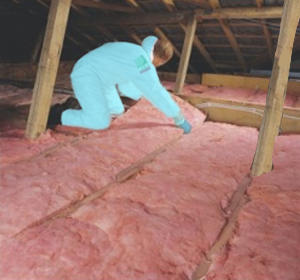Although most people think about insulating  their homes against winter’s cold, summer is also a time when insulation plays an important role.
their homes against winter’s cold, summer is also a time when insulation plays an important role.
Insulation was designed to aid in controlling heat flow between the outside and inside of your home. In winter, it can prevent heat from leaving your home, and insulation in summer can keep heat from entering.
Insulation works by trapping air bubbles within its fibers to create an insulating barrier that prevents heat transfer. The types of insulation that use air bubbles include bulk insulation like fiberglass or wool. Foil insulation is another option, and uses reflection to deflect heat. A combination of the two types are possible as well.
Where Should Insulation Be Placed?
Insulation is generally placed in the attic and inside the walls of a home to create a barrier against heat flow. It also serves to hold in cooler air, and used effectively, can greatly reduce energy bills. Attic insulation can be installed in the roof and laid on the floor for extra insulation, but care must be taken to not impede the flow of air or block soffit or gable vents. Proper airflow prevents the buildup of moisture that can create mold and mildew conditions.
The best time to add insulation to exterior walls is during the construction or remodeling process. When a home was built, it most likely included insulation in the building process.
Weatherstripping is another form of insulation and should be placed around the doors and windows to seal them. Don’t forget to weatherstrip around a window air conditioning unit as well.
An area you do not need to weatherstrip or insulate is the crawlspace. It is shaded year-round and should maintain a lower temperature as a result.
Types of Insulation
A common type of insulation is bulk insulation like wool or pink fiberglass. This generally comes in rolls and is laid on or attached to surfaces within an attic space. Over time, this insulation will settle and become less efficient.
Another type of insulation is injected foam. This product is pumped into the walls of a framed or dry-walled attic to completely fill in any spaces. This prevents gaps in the insulation. Once in place, it hardens to create a solid layer that creates a virtually airtight seal in the outer shell.
Tips to Keeping Your Home Cool in Summer
Instead of running the air conditioning non-stop, try these tricks for keeping your home cooler in summer.
- Open the windows at night to let in the cool air. Close them in the morning to capture the cool air.
- Use a whole-house fan to pull in cool air in the evening. Crack a window on the opposite side of the house from the fan; this will create a tunnel of air that flows throughout the house.
- Close the blinds during the day to keep the sun’s rays from heating the home. Up to 30% of the heat in a home comes in through the windows.
- Don’t run appliances during hot times; all appliances put off heat when running. Use the outdoor grill to create meals.
- Switch to energy-efficient halogen light bulbs; regular incandescent light bulbs issue heat when lit.
- Run the furnace fan to circulate air. Use ceiling fans for the same purpose. Be sure ceiling fans are set to run counter-clockwise for summer.
- Change the air conditioner filter every 4-6 weeks to maintain cooling efficiency.
- Install a programmable or Smart Home thermostat that can cool your home on a programmed schedule.
- Plant greenery and shade trees in the year. Allow for air flow around the foundation by not planting shrubbery too close to the home.
Do You Suspect a Problem With Your Insulation?
When insulation is installed properly it will create a heat barrier and help to decrease heating and cooling expenses. If you suspect that your insulation is not installed properly, and would like to have a professional insulation inspection, please contact Först Consulting Group. As a neutral third-party inspector, we can investigate a contractor’s work or review your existing insulation to look for problems. You will receive a comprehensive report of our findings along with estimated costs to remediate any issues.
Homeowners in the Northern Virginia and Washington DC metropolitan area don’t need to go it alone. When you need a professional home inspection, contact Först Consulting Group.




